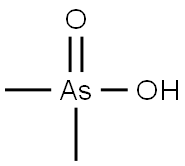General Description
A colorless, odorless crystalline solid. Melting point 195-196°C. Toxic by ingestion and irritating to skin and eyes.
Reactivity Profile
CACODYLIC ACID(75-60-5) is a weak acid. Dissolves in water to yield solutions containing more hydrogen ions than pure water contains and so having a pH less than 7.0. Is neutralized exothermically by all bases to produce water plus a salt. Reacts (but usually slowly) with active metals to form gaseous hydrogen and a metal salt. Such reactions occur in principle for the solid acid but are quite slow if the solid acid remains dry. The solid may absorb enough water from the air and dissolve sufficiently in CACODYLIC ACID(75-60-5) to corrode or dissolve iron, steel, and aluminum parts and containers. Reacts with cyanide salts to generate gaseous hydrogen cyanide. Flammable and/or toxic gases and heat may be generated with diazo compounds, dithiocarbamates, isocyanates, mercaptans, nitrides, and sulfides. Also may react with sulfites, nitrites, thiosulfates (to give H2S and SO3), dithionites (SO2), to generate flammable and/or toxic gases and heat. Reaction with carbonates and bicarbonates generates a harmless gas (carbon dioxide) but still some heat. Can be oxidized exothermically by strong oxidizing agents and reduced by strong reducing agents; a wide variety of products is possible. May initiate polymerization reactions; may catalyze (increase the rate of) chemical reactions.
Air & Water Reactions
Hygroscopic. Water soluble.
Hazard
Toxic by ingestion.
Health Hazard
Chemical is essentially non-irritating in contact with skin or eyes. Ingestion causes arsenic poisoning, but symptoms are delayed.
Fire Hazard
Behavior in Fire: May form toxic oxides of arsenic when heated.
First aid
If this chemical gets into the eyes, remove any
contact lenses at once and irrigate immediately for at least
15 minutes, occasionally lifting upper and lower lids. Seek
medical attention immediately. If this chemical contacts the
skin, remove contaminated clothing and wash immediately
with soap and water. Seek medical attention immediately.
If this chemical has been inhaled, remove from exposure,
begin rescue breathing (using universal precautions, including resuscitation mask) if breathing has stopped and CPR if
heart action has stopped. Transfer promptly to a medical
facility. When this chemical has been swallowed, get medical attention. Give large quantities of water and induce
vomiting. Do not make an unconscious person vomit.
Shipping
UN1572 Cacodylic acid & UN1688 Sodium
Cacodylate, Hazard Class: 6.1; Labels: 6.1-Poisonous materials. UN3465 Organoarsenic compound, solid, n.o.s.,
Hazard Class: 6.1; Labels: 6.1-Poisonous materials,
Technical Name Required
Incompatibilities
A strong reducing agent. Incompatible
with oxidizers (chlorates, nitrates, peroxides, permanganates, perchlorates, chlorine, bromine, fluorine, etc.); contact may cause fires or explosions. Keep away from
alkaline materials, strong bases, strong acids, oxoacids,
epoxides. Aqueous solution reacts violently with chemically active metals releasing toxic arsenic fumes.
Incompatible with oxidizers, sulfuric acid; caustics (strong
bases), reducing agents; ammonia, amines, isocyanates,
alkylene oxides; epichlorohydrin.
Description
Cacodylic acid is a colorless, odorless,crystalline solid arsenic compound. Molecular weight =138.02; Boiling point=200℃; Freezing/Melting point 5192℃. Hazard Identification (based on NFPA-704 MRating System): Health 4, Flammability 0, Reactivity 0.[NJ]Highly soluble in water.
Chemical Properties
white crystals or powder
Uses
A useful arsenic acid for proteomics research. It a good substitute for phosphate in applications to avoid phosphates. Cacodylic Acid is useful for some DNA applications and is also popular in microscopy.
Uses
antieczema, dermatologic, herbicide
Uses
Cacodylic acid is used for dermatologic treatment in cronic eczema, anemia and as a tonic.
Definition
ChEBI: The organoarsenic compound that is arsenic acid substituted on the central arsenic atom with two methyl groups.
reaction suitability
core: arsenic
reagent type: catalyst
Potential Exposure
Used as an herbicide, soil sterilant and intimber thinning. Has been used as a chemical warfare agent.
storage
Color Code—Blue: Health Hazard/Poison: Storein a secure poison location. Prior to working with cacodylicacid you should be trained on its proper handling andstorage. A regulated, marked area should be establishedwhere this chemical is handled, used, or stored in compliance with OSHA Standard 1910.1045. Store in tightlyclosed containers in a cool, well-ventilated area away fromoxidizing agents, chemically active metals, strong bases,moisture, fertilizers, seeds, insecticides, and fungicides.
Purification Methods
Recrystallise it from warm EtOH (3mL/g) by cooling and filtering. Dry it in a vacuum desiccator over CaCl2. It has also been recrystallised twice from propan-2-ol. [Koller & Hawkridge J Am Chem Soc 107 7412 1985, Beilstein 4 IV 3681.]
